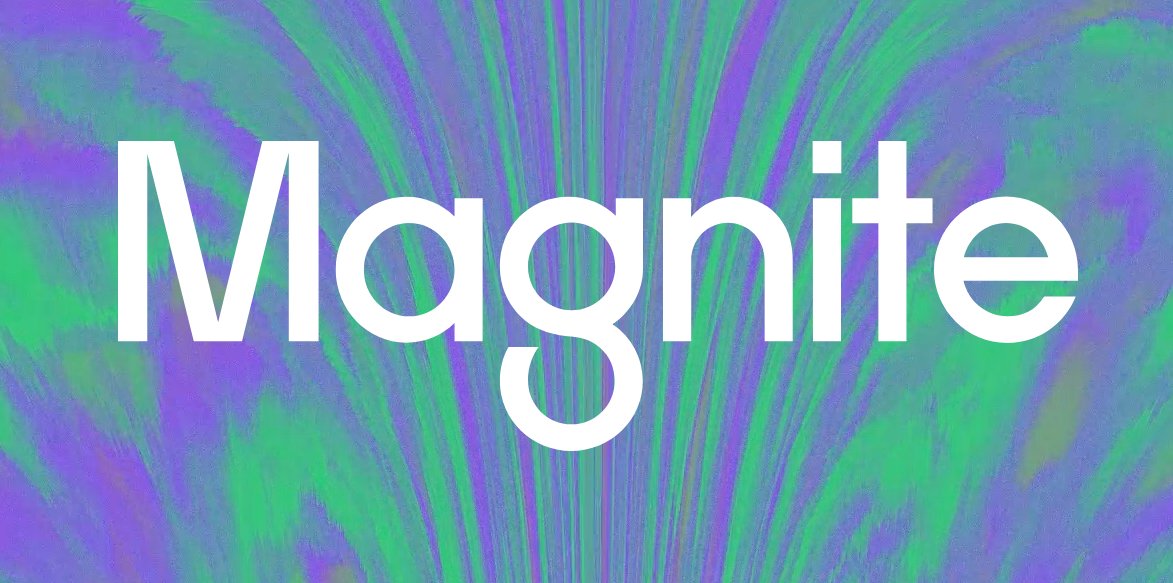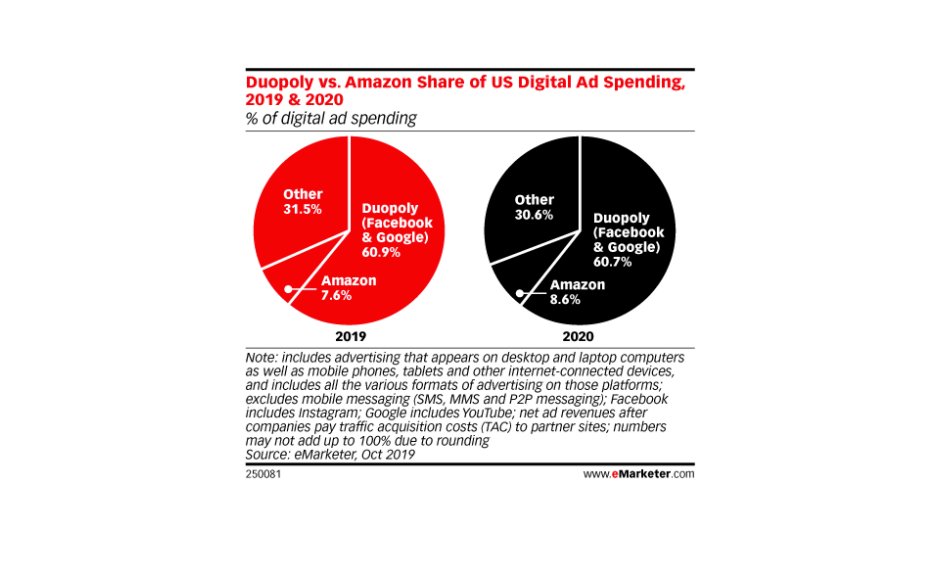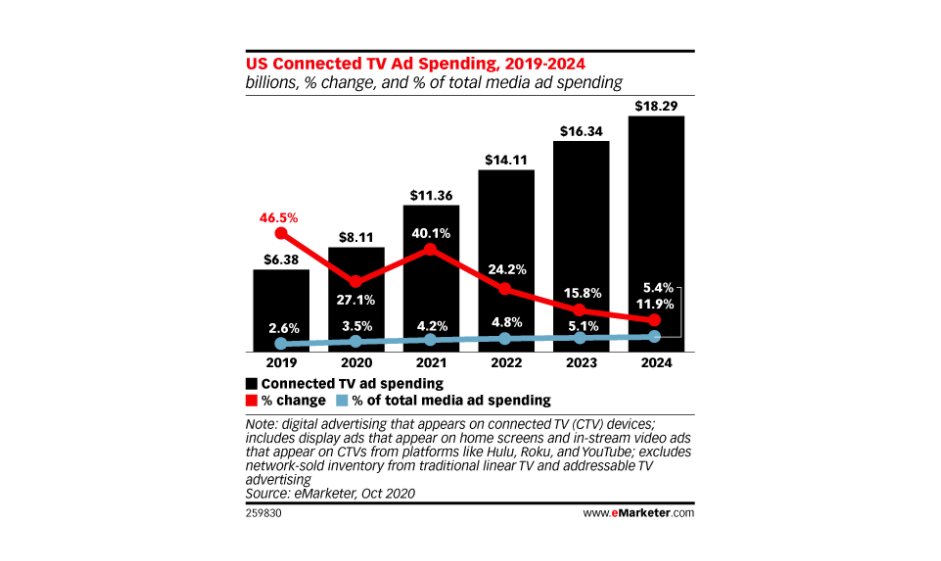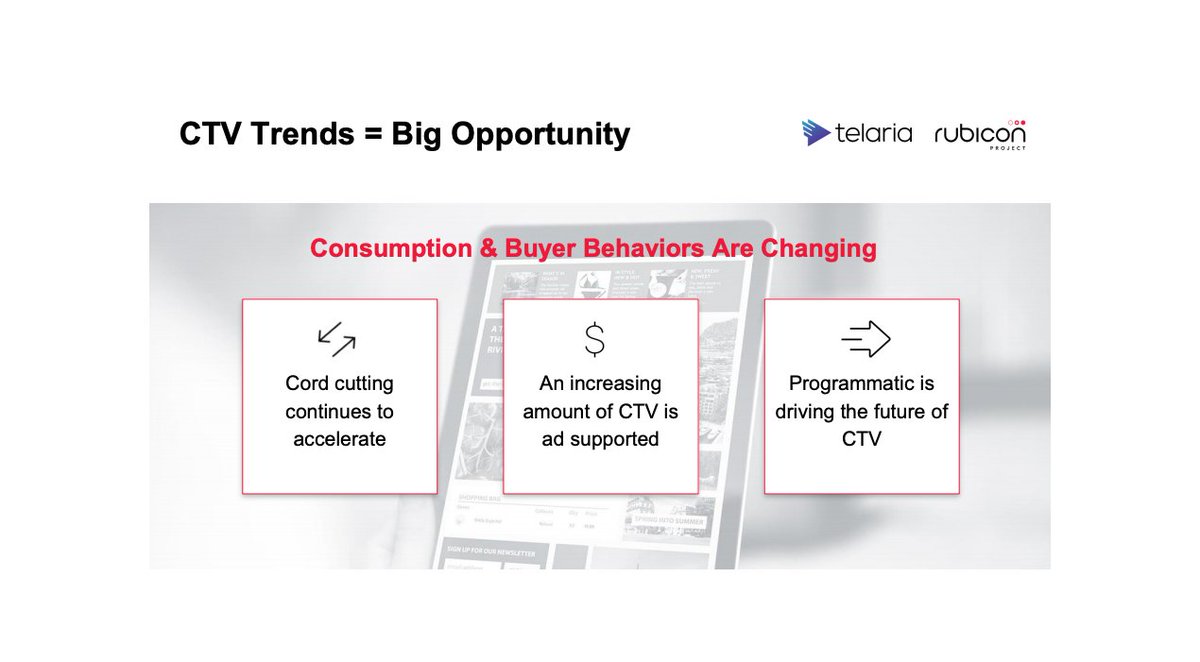 Cord-CUTTING
Cord-CUTTING 
 $MGNI is making inroads into the Connected TV advertising space
$MGNI is making inroads into the Connected TV advertising space Only 40% of advertisers have spent on CTV ads until NOW
Only 40% of advertisers have spent on CTV ads until NOWCan $MGNI profitably grow in this NEW sector?
Here is an EASY thread

$MGNI Magnite is an US based online advertising technology firm  The company was formed following a merger of the Rubicon Project and Telaria
The company was formed following a merger of the Rubicon Project and Telaria
 The merger turned Magnite into one of the world’s largest independent omni-channel sell-side platform
The merger turned Magnite into one of the world’s largest independent omni-channel sell-side platform
 The company was formed following a merger of the Rubicon Project and Telaria
The company was formed following a merger of the Rubicon Project and Telaria The merger turned Magnite into one of the world’s largest independent omni-channel sell-side platform
The merger turned Magnite into one of the world’s largest independent omni-channel sell-side platform
Ok, this isn’t clear. Let’s dive into the world of Advertising Technology
 You are working for Nike’s marketing department and need to get Nike’s ads online
You are working for Nike’s marketing department and need to get Nike’s ads online
 You go on Google Adwords, create an account and start bidding for your adds to get published on sports websites
You go on Google Adwords, create an account and start bidding for your adds to get published on sports websites
 You are working for Nike’s marketing department and need to get Nike’s ads online
You are working for Nike’s marketing department and need to get Nike’s ads online You go on Google Adwords, create an account and start bidding for your adds to get published on sports websites
You go on Google Adwords, create an account and start bidding for your adds to get published on sports websites
 You then visit Facebook, Bings Ads and other websites were you could display your ads
You then visit Facebook, Bings Ads and other websites were you could display your ads You start buying ads, bidding & managing all of these
You start buying ads, bidding & managing all of these Well, you’re soon overwhelmed as you have to manage plenty of different platforms, place bids and monitor your ads’ effectiveness
Well, you’re soon overwhelmed as you have to manage plenty of different platforms, place bids and monitor your ads’ effectiveness
So this is not great! Here comes Demand-Side-Platforms (DSP):
 A DSP is software used by advertisers to buy advertising inventory from publishers
A DSP is software used by advertisers to buy advertising inventory from publishers
 Advertising inventory is the space available from publishers for ads (eg: a box on a website meant to be filled with an ad)
Advertising inventory is the space available from publishers for ads (eg: a box on a website meant to be filled with an ad)
 A DSP is software used by advertisers to buy advertising inventory from publishers
A DSP is software used by advertisers to buy advertising inventory from publishers Advertising inventory is the space available from publishers for ads (eg: a box on a website meant to be filled with an ad)
Advertising inventory is the space available from publishers for ads (eg: a box on a website meant to be filled with an ad)
 A DSP allows for the management of advertising across many real-time bidding networks, as opposed to just one, like Google Ads
A DSP allows for the management of advertising across many real-time bidding networks, as opposed to just one, like Google Ads Using a set of algorithms, a DSP ensures that an advertiser’s ads are displayed to the most relevant viewers
Using a set of algorithms, a DSP ensures that an advertiser’s ads are displayed to the most relevant viewers
 These algorithms use the viewer’s browsing history, time of day, IP address and many other elements into account
These algorithms use the viewer’s browsing history, time of day, IP address and many other elements into accountSo, problem solved! Instead of crawling through advertising platforms
 You log into to your favourite DSP, set your criteria and bidding budget and off you go
You log into to your favourite DSP, set your criteria and bidding budget and off you go
But we are still missing a piece of the total equation!
 Advertisers use a Demand Side Platform to have their ads displayed
Advertisers use a Demand Side Platform to have their ads displayed
 But how do websites / publishers make sure that their DSPs know about their advertising inventory?
But how do websites / publishers make sure that their DSPs know about their advertising inventory?
 Advertisers use a Demand Side Platform to have their ads displayed
Advertisers use a Demand Side Platform to have their ads displayed But how do websites / publishers make sure that their DSPs know about their advertising inventory?
But how do websites / publishers make sure that their DSPs know about their advertising inventory?
 In other words, how to publishers make sure they sell their advertising inventory?
In other words, how to publishers make sure they sell their advertising inventory? Here come SUPPLY Side Platforms (SSP)
Here come SUPPLY Side Platforms (SSP)
SSP platforms work in the same way as DSP, the difference is that publishers rather than advertisers use these
 A SSP send its available ad impressions to potential buyers
A SSP send its available ad impressions to potential buyers
 The goal of the SSP is to send as much ad impressions AND get the best price as possible
The goal of the SSP is to send as much ad impressions AND get the best price as possible
 A SSP send its available ad impressions to potential buyers
A SSP send its available ad impressions to potential buyers The goal of the SSP is to send as much ad impressions AND get the best price as possible
The goal of the SSP is to send as much ad impressions AND get the best price as possible
 The SSP evaluates the requirements matching the right bids with the right publisher and send its “offer” (request) to the ad exchange
The SSP evaluates the requirements matching the right bids with the right publisher and send its “offer” (request) to the ad exchange The winning bid from the DSP-side (advertisers) get its ads displayed on the publisher’s media
The winning bid from the DSP-side (advertisers) get its ads displayed on the publisher’s media
This falls under Programmatic Advertising
 It is the process of buying and selling ads with software and publishing those ads on the right website using algorithms
It is the process of buying and selling ads with software and publishing those ads on the right website using algorithms
 Most online advertising now is done programmatically through real-time bidding and direct deals
Most online advertising now is done programmatically through real-time bidding and direct deals
 It is the process of buying and selling ads with software and publishing those ads on the right website using algorithms
It is the process of buying and selling ads with software and publishing those ads on the right website using algorithms Most online advertising now is done programmatically through real-time bidding and direct deals
Most online advertising now is done programmatically through real-time bidding and direct deals
Here is the full review:
https://instapage.com/blog/demand-side-platform https://publift.com/what-is-supply-side-platform/
https://instapage.com/blog/demand-side-platform https://publift.com/what-is-supply-side-platform/
And where does MGNI fits in? $MGNI is an independent Supply Side Platform
It thus competes with other SSPs but also with advertising giants such as Google, Facebook and even Amazon
 Given their daily page views, these giants have a lot of advertising inventory to sell
Given their daily page views, these giants have a lot of advertising inventory to sell
It thus competes with other SSPs but also with advertising giants such as Google, Facebook and even Amazon
 Given their daily page views, these giants have a lot of advertising inventory to sell
Given their daily page views, these giants have a lot of advertising inventory to sell
 $MGNI could face difficulties if these giants start preferring publishers and advertisers they have a stake into
$MGNI could face difficulties if these giants start preferring publishers and advertisers they have a stake into Or if Google for example starts using its server advantages to outbid $MGNI in open-market transactions
Or if Google for example starts using its server advantages to outbid $MGNI in open-market transactions
But how are these giants’ sales evolving? Here is from eMarketer
 The Facebook - Google Duopoly’s share of US digital advertising is decreasing from 60.9% in 2019 to 60.7%
The Facebook - Google Duopoly’s share of US digital advertising is decreasing from 60.9% in 2019 to 60.7%
 The Facebook - Google Duopoly’s share of US digital advertising is decreasing from 60.9% in 2019 to 60.7%
The Facebook - Google Duopoly’s share of US digital advertising is decreasing from 60.9% in 2019 to 60.7%
On the other hand, smaller publishers are consolidating:
“To better compete with them, smaller publishers are also consolidating and partnering up in other ways to allow advertisers to buy audiences at scale.”
“To better compete with them, smaller publishers are also consolidating and partnering up in other ways to allow advertisers to buy audiences at scale.”
“Notable recent acquisitions include Vox Media’s purchase of New York Media and Vice’s purchase of Refinery29”
from https://www.emarketer.com/content/facebook-google-duopoly-won-t-crack-this-year
from https://www.emarketer.com/content/facebook-google-duopoly-won-t-crack-this-year
Competition is also coming social media players as $PINS $SNAP $TWTR 
“Strong reports from smaller advertising players shows there is still an appetite from marketers to diversify their ad spend across platforms. New advertising offerings could also be luring in businesses.”

“Strong reports from smaller advertising players shows there is still an appetite from marketers to diversify their ad spend across platforms. New advertising offerings could also be luring in businesses.”
“Amazon and Twitter executives both told analysts on their earnings calls that new and improved product offerings overall are giving advertisers more of a reason to advertise with them.”
By Lauren Feiner for CNBC https://www.cnbc.com/2019/08/02/facebook-and-googles-ad-dominance-is-showing-more-cracks.html
By Lauren Feiner for CNBC https://www.cnbc.com/2019/08/02/facebook-and-googles-ad-dominance-is-showing-more-cracks.html
This is good and bad news at the same time
 Large publishers such as Google and Facebook are loosing ground
Large publishers such as Google and Facebook are loosing ground
 Smaller publishers are gaining share and consolidating on their turn
Smaller publishers are gaining share and consolidating on their turn
 Demand for the Rubicon Project’s product is growing but reflects the weakness listed above
Demand for the Rubicon Project’s product is growing but reflects the weakness listed above
 Large publishers such as Google and Facebook are loosing ground
Large publishers such as Google and Facebook are loosing ground Smaller publishers are gaining share and consolidating on their turn
Smaller publishers are gaining share and consolidating on their turn Demand for the Rubicon Project’s product is growing but reflects the weakness listed above
Demand for the Rubicon Project’s product is growing but reflects the weakness listed above
Here is the Rubicon Project’s sales growth over the last quarters 
· 27% in Q3 2019
· 17% in Q4 2019
· 12% in Q1 2020
· 12% in Q2 2020 (for the whole Magnite Group)
· 12% in Q3 2020 (for the whole Magnite Group)

· 27% in Q3 2019
· 17% in Q4 2019
· 12% in Q1 2020
· 12% in Q2 2020 (for the whole Magnite Group)
· 12% in Q3 2020 (for the whole Magnite Group)
But what is the pitch for $MGNI 
There is one thing showing tremendous growth each quarter: Connected TV (CTV)
“CTV revenue grew 51% year over year in Q3 2020 to $11.1 million on a pro forma basis” - $MGNI Q3 ’20 Report
 $MGNI expects strong CTV growth in Q4 2020
$MGNI expects strong CTV growth in Q4 2020

There is one thing showing tremendous growth each quarter: Connected TV (CTV)

“CTV revenue grew 51% year over year in Q3 2020 to $11.1 million on a pro forma basis” - $MGNI Q3 ’20 Report
 $MGNI expects strong CTV growth in Q4 2020
$MGNI expects strong CTV growth in Q4 2020
The $MGNI story is all about serving ads to CTV
 According to eMarketer, the CTV ad spend is set to rise from $ 6.4B in 2019 to $ 18.3B in 2024
According to eMarketer, the CTV ad spend is set to rise from $ 6.4B in 2019 to $ 18.3B in 2024
 With revenues from YouTube, Hulu and Roku representing around 50% of all CTV ad sales
With revenues from YouTube, Hulu and Roku representing around 50% of all CTV ad sales
https://www.emarketer.com/content/us-connected-tv-advertising-2020
 According to eMarketer, the CTV ad spend is set to rise from $ 6.4B in 2019 to $ 18.3B in 2024
According to eMarketer, the CTV ad spend is set to rise from $ 6.4B in 2019 to $ 18.3B in 2024 With revenues from YouTube, Hulu and Roku representing around 50% of all CTV ad sales
With revenues from YouTube, Hulu and Roku representing around 50% of all CTV ad saleshttps://www.emarketer.com/content/us-connected-tv-advertising-2020
On top of this, eMarketer found out that this channel was still little used by advertisers 
“We found that while CTV/OTT spend has increased, there is a significant opportunity for advertisers to include these channels in their marketing mix.”

“We found that while CTV/OTT spend has increased, there is a significant opportunity for advertisers to include these channels in their marketing mix.”
“Fewer than 40% of advertisers have spent on CTV/OTT channels in the past year, significantly lagging behind social media, display, and non-CTV/OTT video.”
from https://www.emarketer.com/content/ott-ctv-advertising-will-breakout-star-of-2021-sponsored-content
from https://www.emarketer.com/content/ott-ctv-advertising-will-breakout-star-of-2021-sponsored-content
This explains the rationale behind the Telaria and Rubicon Project merger
 Use the Rubicon Project experience with ad exchanges
Use the Rubicon Project experience with ad exchanges
 And Telaria’s expertise in CTV ads
And Telaria’s expertise in CTV ads
 Use the Rubicon Project experience with ad exchanges
Use the Rubicon Project experience with ad exchanges And Telaria’s expertise in CTV ads
And Telaria’s expertise in CTV ads
 Financials Check
Financials Check 
 Sales grew 12% YoY in Q3 ’20 to $ 61m with 74% of sales coming from the USA
Sales grew 12% YoY in Q3 ’20 to $ 61m with 74% of sales coming from the USA CTV sales grew 51% YoY to $ 11.1m
CTV sales grew 51% YoY to $ 11.1m Net income stood at $ 10.5m down from $ 6.2m a year earlier
Net income stood at $ 10.5m down from $ 6.2m a year earlier Cash & equivalents stood at $ 103.8m down from $ 107.5m a year earlier
Cash & equivalents stood at $ 103.8m down from $ 107.5m a year earlier
 THE BOTTOM LINE
THE BOTTOM LINE 
 In a pre-Covid world, the Rubicon Project was growing at above 25% year over year but saw its growth slow down following the pandemic
In a pre-Covid world, the Rubicon Project was growing at above 25% year over year but saw its growth slow down following the pandemic The merger with Telaria provides an interesting growth allay as connected TVs are becoming omnipresent
The merger with Telaria provides an interesting growth allay as connected TVs are becoming omnipresent
 The CTV advertising market is still little penetrated as fewer than 40% of advertisers pushed their adds to CTV
The CTV advertising market is still little penetrated as fewer than 40% of advertisers pushed their adds to CTV As a merged entity, $MGNI has a real chance to become the leading ind. supply side platform for CTV, a market that is set to triple over the 2019 - 2024 period
As a merged entity, $MGNI has a real chance to become the leading ind. supply side platform for CTV, a market that is set to triple over the 2019 - 2024 period
 When looking at the mobile and desktop ads - which accounts for more than 80% of $MGNI ’s sales - the current digital advertising landscape (non-CTV) is lead by Facebook and Google and these dictate their prices and rules
When looking at the mobile and desktop ads - which accounts for more than 80% of $MGNI ’s sales - the current digital advertising landscape (non-CTV) is lead by Facebook and Google and these dictate their prices and rules
 Smaller publishers that provide advertising inventory are growing and consolidating in order to increase their bargaining power and prices
Smaller publishers that provide advertising inventory are growing and consolidating in order to increase their bargaining power and prices The risks exists that some players such as Disney (through Hulu With Live TV) and YouTube TV form a duopoly, decreasing $MGNI appeal
The risks exists that some players such as Disney (through Hulu With Live TV) and YouTube TV form a duopoly, decreasing $MGNI appeal
 We stay on the sidelines for now and will review $MGNI at the next earnings
We stay on the sidelines for now and will review $MGNI at the next earnings 
 $RKT is on our watchlist
$RKT is on our watchlist  To Be Reviewed SOON
To Be Reviewed SOON 
Disclaimer - This is not investment advice in any form and investors are responsible for conducting their own research before investing.
Sources
✑ Investor presentation
✑ Company website
✑ eMarketer
✑ CNBC
✑ Instapage
✑ Clearcode
✑ Statista
✑ Forbes
Sources
✑ Investor presentation
✑ Company website
✑ eMarketer
✑ CNBC
✑ Instapage
✑ Clearcode
✑ Statista
✑ Forbes
Hope you liked this thread!
 For more content, follow us on Twitter
For more content, follow us on Twitter 
 EASY BRIEFINGS delivered straight to your inbox
EASY BRIEFINGS delivered straight to your inbox  Don’t MISS IT
Don’t MISS IT  https://getbenchmark.substack.com
https://getbenchmark.substack.com
 For more content, follow us on Twitter
For more content, follow us on Twitter 
 EASY BRIEFINGS delivered straight to your inbox
EASY BRIEFINGS delivered straight to your inbox  Don’t MISS IT
Don’t MISS IT  https://getbenchmark.substack.com
https://getbenchmark.substack.com

 Read on Twitter
Read on Twitter






